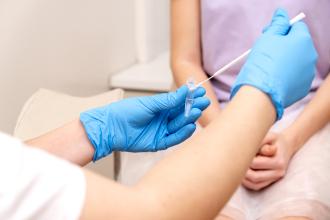New method of HIV transmission and effective prevention technique
New studies from Lawson Health Research Institute and Western University have found for the first time that HIV can be transmitted through the sharing of equipment used to prepare drugs before injection and that a simple intervention—heating the equipment with a cigarette lighter for 10 seconds—can destroy the virus, preventing that transmission. The findings, used to inform a public health campaign called Cook Your Wash, have helped reduce rates of HIV transmission in London, Ontario.
The two studies published in the Journal of Acquired Immune Deficiency Syndromes were initiated in 2016 to address a public health emergency in London, Ontario, when HIV rates among injection drug users more than doubled. The outbreak occurred despite London having Canada’s largest per capita sterile needle and syringe distribution program, a strong opiate substitution therapy program, and a multidisciplinary HIV clinic, so researchers knew there must be a novel method of HIV transmission at play.
From August 2016 to June 2017, the research team interviewed 119 injection drug users to understand their injection behaviors and risk for HIV. They discovered that those who shared equipment used to prepare drugs for injection were 22 times more likely to contract HIV than those who did not, despite not sharing needles or syringes.
The equipment includes a metal cooker used to dissolve drugs in water and a filter used to draw the mixture, known as the wash, into the syringe. Injection drug users reported reusing the equipment when consuming controlled-release hydromorphone, one of the most commonly injected opioids.
Controlled-release hydromorphone is expensive and difficult to dissolve. After the first wash, large amounts of the drug remain in the equipment which is then saved, shared, or sold for future use. While people know not to share needles, some use their own needle multiple times, allowing for contamination of the equipment.
The team took their findings back to the research laboratory and confirmed that, on average, 45% of the drug remains in the equipment after the first wash and that HIV can be transmitted between needles, cookers, and filters. They also discovered that controlled-release hydromorphone has properties that promote survival of the virus. However, when the cooker is heated with a cigarette lighter for approximately 10 seconds, or until the wash bubbles, the virus is destroyed. Heating the cooker did not impact drug concentration. They termed the technique “cook your wash.”
After running a Cook Your Wash public health campaign with local community groups, local rates of new HIV cases fell dramatically. While the researchers acknowledge that the campaign wasn’t the sole reason for the reduction in HIV rates as other interventions were also introduced, the timing suggests it was part of the solution.
The studies build on previous research that shows sharing equipment can lead to the transmission of hepatitis C, and controlled-release hydromorphone can promote the survival of bacteria that can cause endocarditis.

